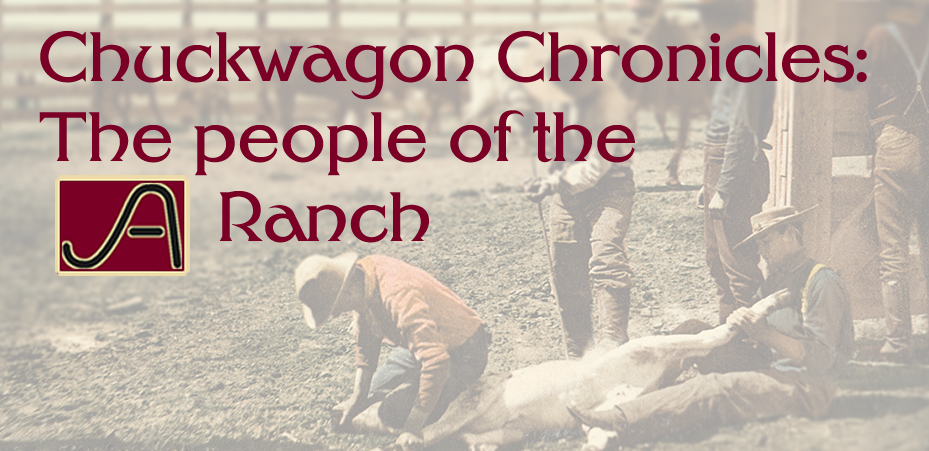 Spreading the Gospel: The American Bible Society
Spreading the Gospel: The American Bible Society
In his 1965 dissertation, Fundamentalism and the Frontier: Value Clusters in the Texas Panhandle, Benjamin Lee Gorman established five values – fundamentalism, puritanism, spirit of the frontier, entrepreneurship, and toryism – as a collection of beliefs that are defining characteristics of the Panhandle. Although Gorman’s research was conducted 40 years after the period under study, his work rests upon a historical analysis of the forces still in play on the ranch during the 1920’s.1
Sketchup model of the schoolhouse on the JA Ranch circa 1930. The building was also used for Sunday services. Image created by Kim Nettles, 2016.
Gorman asserts that fundamentalist Christian beliefs were introduced to the area by farmers migrating to the region from the Appalachians, along with puritanism, which is an ascetic set of religious moral codes. These beliefs were the product of the combined effects of emigration origin (from other distinct parts of the US as well as foreign-born) and the ascetic Protestant traditions of those families. The “spirit of the frontier” encapsulates Frederick Jackson Turner’s thesis that frontier people value individualism, survival of the fittest, improvisation, equalitarian society, and a deep attachment to nature. Entrepreneurship is a willingness to risk present income in hope of future gain. Toryism, as used by Gorman, refers to a political desire to maintain the status quo. These five characteristics, Gorman argues, are mutually reinforcing and self-perpetuating.2
Gorman’s study was based upon interviews with 224 non-urban residents of four Panhandle counties, including two associated with the JA Ranch. The results of his analysis found that the value set has two clusters: Fundamentalism and puritanism are one; entrepreneurship, toryism, and a frontier spirt are the second . The higher the puritanism of a subject, the less likely he is to be an entrepreneur. By occupation, white collar workers (professional, large business, and managerial) were significantly less likely to be fundamentalist than every other category. Puritanism, while closely associated with fundamentalism, was more widely distributed to include lower-income white-collar workers. Perhaps most notably for the purposes of this study, the so-called “spirit of the frontier” values had the lowest correlation with Rural Armstrong County: the heart of the JA Ranch. Gorman found that the frontier spirit was closely associated with age and education.3 The significance of this in terms of current and former Ranch employees is unclear.
A Methodist Christian Colony settled northeast of the JA Ranch in 1879, composed of twenty-five or thirty families. According to Charles Goodnight, though the settlers were well-educated, they were poorly suited for frontier life and most of them had left the country by 1925.4 This settlement eventually became the town of Clarendon, an important rail shipping point. The “social values” influence of those that remained may be worth some exploration.
For residents of the JA Ranch, the school doubled as a church meeting house when a preacher was available. Otherwise, if they wished to attend formal services, they had to travel to a town at the outskirts of the ranch. Given the distances and logistics challenges this involved, it is possible that they relied on “do it yourself” options (e.g., scripture reading, tracts, or periodicals) to a greater degree than those in more densely populated areas.
An examination of American Bible Society (ABS) distribution figures from 1895-1905 sheds a bit of light on the subject. The American Bible Society is a non-denominational organization founded in 1816 with a mission to translate, publish, and distribute the Bible and related tracts. The Society’s “Bible House” was the largest publishing operation in the United States when it opened in 1853, serving as the central publishing site and using many innovative technologies and management strategies to minimize costs. These volumes were distributed locally by colporteurs (door-to-door peddlers of religious books and tracts).5
ABS annual reports include data on state-by-state distribution of Bible House materials. I have extracted information for the years 1895-1905 for some initial analysis of the extent of their reach in to Texas. Each annual report covers April-Decemeber of the previous year and January-March of the marked year. For the purposes of this analysis, I will refer to year of the annual report. (Although ABS records for county-level dissemination may exist, my work so far is limited to records available online.)6
To begin, I normalized the distribution figures against the US Census state population figures for 1900, which falls in the middle of the date range for this analysis.7 The resulting figure is expressed as the number of books distributed as a percentage of each state’s population. The histogram below shows the frequency of the distribution percentages during this 10-year period.
ABS rarely broke .02 percent of a state’s population over the decade. When it did, the achievment was almost always the same few, geographically clustered states (though one does wonder what happened in North Carolina in 1894-1895):
## books_per_pop ar_year location
## 1 0.05890190 1895 North Carolina
## 2 0.04428409 1899 Florida
## 3 0.03469592 1905 New York
## 4 0.03444700 1899 District of Columbia
## 5 0.03199565 1896 New York
## 6 0.03110762 1904 New York
## 7 0.03105493 1903 New York
## 8 0.03050918 1902 New York
## 9 0.02988473 1897 Massachusetts
## 10 0.02924820 1897 District of Columbia
## 11 0.02817719 1895 New York
## 12 0.02775924 1897 New York
## 13 0.02694476 1895 Pennsylvania
## 14 0.02676377 1899 New York
## 15 0.02513045 1896 Pennsylvania
## 16 0.02326850 1904 Maryland
## 17 0.02319541 1901 New York
## 18 0.02318358 1900 New York
## 19 0.02310544 1898 New York
## 20 0.02255552 1895 Vermont
## 21 0.02233631 1904 Pennsylvania
## 22 0.02177015 1905 Pennsylvania
## 23 0.02157022 1903 Pennsylvania
## 24 0.02111736 1902 Pennsylvania
## 25 0.02054725 1904 New Hampshire
## 26 0.02053712 1900 Maryland
## 27 0.02037803 1905 Maryland
## 28 0.02015750 1903 MarylandIn 1890, the frontier had been officially declared closed by the Superintendent of the US Census. How well was ABS doing in its outreach to states in the former frontier?
According to this sample of four states (Colorado, Kansas, Texas, and Utah), distribution percentages declined from 1895-1905. In no case did it ever break .01 percent.
By contrast, high-distribution states typically remained fairly constant:
This is not to suggest that the ABS was not making an effort. A series of choropleth maps for 1895, 1900, and 1905 are suggestive of a relationship between the location of the centralized publishing operation (Bible House)in New York and its relationship to transportation nodes, which would primarily be rail for long-distance. Darker shades represent the higher numbers of volumes distributed. (Blank states have no data recorded by the ABS for that year.)
What does this have to do with Texas and the JA Ranch? Let’s take a look at one more map: Distribution as a percentage of population in 1905.
In that year, total volume distribution in Texas was 7,594 for a population of over 3 million people. According to the 1905 Annual Report, there were 3 ABS auxilliary societes in Texas, none located in the Panhandle. 8The low numbers for 1905 are not a fluke; from 1895-1905, the total number of volumes distributed in the state declined. As a source of influence in the Texas Panhandle, distributions from the American Bible Society are not a likely prospect for further research.
Why might this be so? According to the Oxford History of Popular Print Culture, the logistics of book distribution from publisher to consumer were still plagued by the limitations of the transportation infrastructure during this period. Magazines, newspapers, and other small periodicals were a more efficient way of sharing religious doctrine and ideas. For example, in 1850, religious periodicals made up nearly a third of total circulation. These periodicals tended to be denominational in emphasis, as opposed to the broader evangelical Christian focus of organizations such as the ABS.9 (The American Bible Society Record had a subscriber base of 17,000 in 1905.)10
Although this line of inquiry did not pan out, the process of research and analysis for it developed several questions for further investigation:
1Gorman, Benjamin L. Fundamentalism and the Frontier: Value Clusters in the Texas Panhandle, 1965, pp. 78.
2Ibid. pp 65-69.
3Ibid. pp 119-141.
4Burton, Harley True, “A History of the J A Ranch, III,” The Southwestern Historical Quarterly 31, no. 4 (April 1, 1928): 325–64, pp. 345-346.
5Bold, Christine. The Oxford History of Popular Print Culture, 2012, p. 278.
6Annual Reports for the American Bible Society were downloaded from the Hathi Trust Digital Library, February, 2016. https://catalog.hathitrust.org/Record/007844426
7U.S. Census data is available here: https://www.census.gov/prod/www/decennial.html.
8American Bible Society Annual Report, 1905. Downloaded from the Hathi Trust Digital Archive, May 2016. https://babel.hathitrust.org/cgi/pt?id=umn.31951p01104237d;view=1up;seq=30
9 The Oxford History of Popular Print Culture, p. 280.
10American Bible Society Annual Report, 1905.

